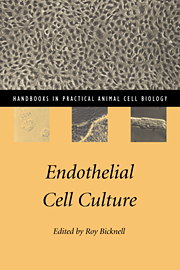Book contents
- Frontmatter
- Contents
- List of Contributors
- Preface to the series
- Acknowledgement
- 1 Introduction to the endothelial cell
- 2 Lung microvascular endothelial cells: defining in vitro models
- 3 Bone marrow endothelium
- 4 Endothelium of the brain
- 5 Isolation, culture and properties of microvessel endothelium from human breast adipose tissue
- 6 Human skin microvascular endothelial cells
- 7 Microvascular endothelium from adipose tissue
- 8 Endothelium of the female reproductive system
- 9 Synovial microvascular endothelial cell isolation and culture
- Index
7 - Microvascular endothelium from adipose tissue
Published online by Cambridge University Press: 03 November 2009
- Frontmatter
- Contents
- List of Contributors
- Preface to the series
- Acknowledgement
- 1 Introduction to the endothelial cell
- 2 Lung microvascular endothelial cells: defining in vitro models
- 3 Bone marrow endothelium
- 4 Endothelium of the brain
- 5 Isolation, culture and properties of microvessel endothelium from human breast adipose tissue
- 6 Human skin microvascular endothelial cells
- 7 Microvascular endothelium from adipose tissue
- 8 Endothelium of the female reproductive system
- 9 Synovial microvascular endothelial cell isolation and culture
- Index
Summary
Introduction
The pioneering work of Lewis in the 1920s provided the groundwork for the eventual establishment of both large blood vessel and microvessel derived endothelial cell cultures (Lewis, 1922). The earliest report of methods for the isolation of microvessel derived endothelial cells, and in particular endothelial cells derived from microvascularised fat, was a publication by Wagner and colleagues in 1972. The choice of fat as a source of tissue was based on its ready availability, its high density of microvascular endothelial cells and previously established methods for the digestion of adipose tissue using proteolytic enzyme solutions containing crude clostridial collagenase. Thus the choice of fat tissue as a source of endothelium was not based on specific properties to be studied. In fact Wagner's report provided initial evidence that not only microvascular endothelium but endothelium in general exhibited specific metabolic activities. The tenet that endothelium existed as a metabolically inert ‘Cellophane’ lining was initially questioned by Wagner's evaluation of isolated fat-derived microvascular endothelial cells.
Since these early studies using adipose tissue derived endothelium, investigators have begun to evaluate microvascular endothelial cells from essentially every vascularised tissue in the body. Continued interest in adipose tissue endothelial cells persists for the following reasons: (1) studies of obesity and general nutrition, (2) studies of the augmentation of wound healing by the presence of adipose tissue and (3) the use of adipose tissue derived endothelium for cell transplantation. Obesity and nutrition studies have utilised adipose-derived endothelium to evaluate their role in anabolic and catabolic activity and in the regulation of nutrient and waste product transport between blood and adipocytes.
- Type
- Chapter
- Information
- Endothelial Cell Culture , pp. 91 - 100Publisher: Cambridge University PressPrint publication year: 1996

